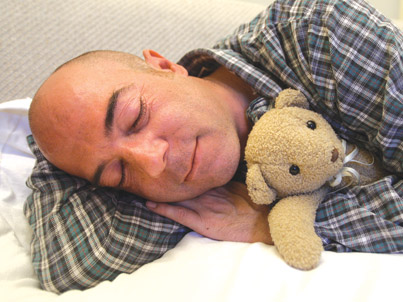Bourguignon Beat: Coming up for air
Bourguignon Beat: Coming up for air McGill University
User Tools (skip):
Coming up for air

Michael Bourguignon (left) and Mr. Cuddles (right): breathing more easily for a good night’s sleep.
Owen Egan
Royal Vic Sleep Clinic breathes hope into case of hypopnea
It's 3 a.m. and I've just been jolted awake yet again, not by my girlfriend forcefully rolling me over to ease my cacophonous snoring, nor by the cat suddenly leaping onto my chest – both of which tend to happen with alarming frequency.
My own body has ripped me from my slumber in a desperate bid for oxygen.
My family medical history includes cardiovascular disease, various cancers, diabetes, excess iron in the blood and sudden unexplained bleeding of the brain. It's a wonder I'm still alive.
Another shared trait, at least among the men in my immediate family, is apocalyptic snoring of the sort that makes our significant others significantly more sleep deprived than ourselves. Lately, though, I have been waking up a lot throughout the night, apparently gasping for breath.
The medical experts sometimes call this obstructive sleep apnea (OSA). My girlfriend calls it just plain scary. Imagine lying in bed next to someone who stops breathing for 10 seconds or more and then suddenly bolts upright, gasping. It's neither attractive nor particularly conducive to a good night's sleep.
So like any good modern-day would-be patient, I headed to the Internet to research OSA, a potentially dangerous condition characterized by an over-relaxed throat basically collapsing onto itself in the night and obstructing the airway – causing breathing to stop for at least 10 seconds.
I figured if I was going to get it checked out, our own McGill University Health Centre would be a good place to start. So I made an appointment at the Sleep Clinic at the Royal Victoria Hospital, where the director, Dr. John Kimoff, agreed to see me after first setting me up with a take-home device that would provide insight as to what goes on when the lights go off.
I was instructed to go to the sleep lab to pick up the "device to rule out OSA" – an intricate piece of equipment that I would strap to my chest, tubes stuck up my nose, a clamp on my index finger and other really, really uncomfortable monitoring accoutrements.
I quietly made my way down the corridor of the lab, aware that behind some of the closed doors to my left and right, actual patients were sleeping, likely also strapped into weird monitoring gizmos.
My first encounter there was with Naftaly Naor, a polysomnography technologist, who outfitted me with the take-home device, which he said would monitor my breathing, heart rate, even what position I would be sleeping in at any given time. Based on my test results, Dr. Kimoff would have me in for an interview.
The diagnosis was swift and delivered by email: "Your test results are unequivocally positive for moderate, position-related obstructive sleep hypopnea," he wrote.
Hypopnea? What was this?
While apnea involves a total obstruction of the airway, with hypopnea, there's only a partial obstruction, Dr. Kimoff explained. In my case, the condition is position-related because it's worse when I'm sleeping on my back – which I apparently did 45 per cent of the time that night, versus 55 per cent on my side.
Well, that didn't sound so bad, until he told me that I stopped breathing an average of 27 times an hour – for up to 17 seconds at a time – and up to 44 times per hour while sleeping on my back. I also happen to have gastric reflux, so that probably doesn't help matters.
The good news, pending follow-up, is that the solution may be as simple as behaviour modification: staying away from alcohol and cigarettes before bed, sleeping on my side instead of on my back, etc. No word yet on whether I will eventually have to wear a night-time oxygen mask, called a Continuous Positive Airway Pressure (or CPAP) machine.
I'm earnestly hoping – as is my girlfriend – that it won't come to that.
U.S. studies have linked severe, untreated apnea/hypopnea with increased risk of cardiovascular mortality – heart attack, stroke – so it's not something to be taken lightly. The disorder can even cause changes in personality, according to Naftaly Naor.
"There can be psychosomatic effects that create a vicious cycle of fear of going to bed, which can lead to nightmares and panic attacks in some patients," Naor said.
Not in my case, thankfully, but I am definitely looking forward to learning what tools are available so I can finally breathe easy and get a good night's sleep.
Now if you'll excuse me, I'm off to take a nap.

